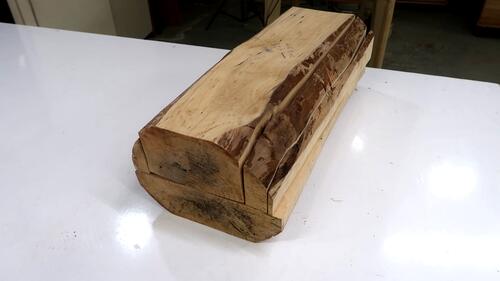
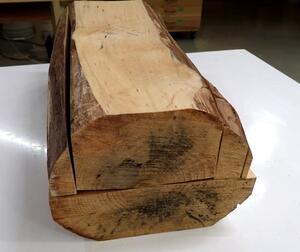 Early last year our neighbour cut down a birch tree. I got a short section
of the trunk and milled it up on the bandsaw to use later. Here are the pieces
arranged the way they came out of the log after drying.
Early last year our neighbour cut down a birch tree. I got a short section
of the trunk and milled it up on the bandsaw to use later. Here are the pieces
arranged the way they came out of the log after drying.

 Early last year our neighbour cut down a birch tree. I got a short section
of the trunk and milled it up on the bandsaw to use later. Here are the pieces
arranged the way they came out of the log after drying.
Early last year our neighbour cut down a birch tree. I got a short section
of the trunk and milled it up on the bandsaw to use later. Here are the pieces
arranged the way they came out of the log after drying.
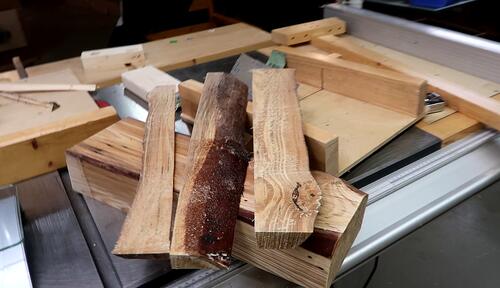 The wood was completely wet at the time I cut it and I wondered how long it
would take to dry enough to be able to use it.
The wood was completely wet at the time I cut it and I wondered how long it
would take to dry enough to be able to use it.
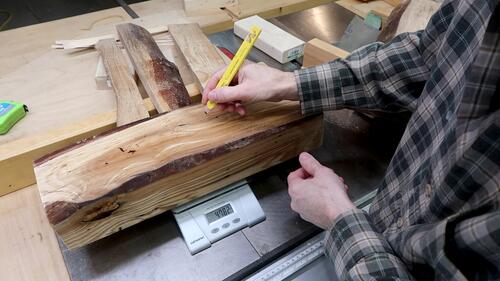 So I weighed all the pieces on our kitchen scale and marked down how they
weighed.
So I weighed all the pieces on our kitchen scale and marked down how they
weighed.
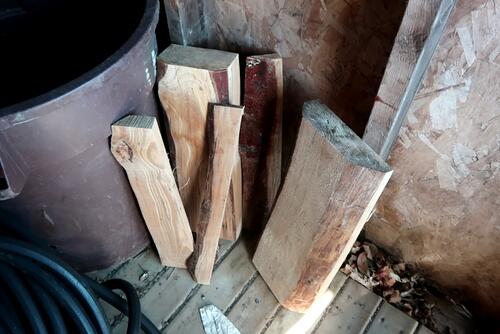 I put the pieces in our shed to dry over the summer and weighed them every month.
I put the pieces in our shed to dry over the summer and weighed them every month.
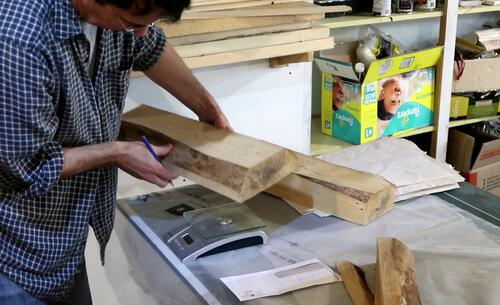 As the year turned to fall and the weather got wetter, I moved the pieces into
the basement and continued to weigh them every month.
As the year turned to fall and the weather got wetter, I moved the pieces into
the basement and continued to weigh them every month.
| Thickness | |||||
|---|---|---|---|---|---|
| Date | 7mm | 20mm | 25mm | 60mm | 75mm |
| 2-May-19 | 142 | 689 | 729 | 4778 | 4782 |
| 6-May-19 | 79 | 507 | 576 | 4244 | 4400 |
| 3-Jun-19 | 78 | 408 | 400 | 3194 | 3494 |
| 4-Jul-19 | 77 | 396 | 391 | 2820 | 3006 |
| 5-Aug-19 | 75 | 386 | 382 | 2723 | 2802 |
| 5-Sep-19 | 77 | 391 | 388 | 2736 | 2787 |
| 7-Oct-19 | 76 | 383 | 379 | 2663 | 2716 |
| 4-Nov-19 | 75 | 382 | 379 | 2653 | 2703 |
| 2-Dec-19 | 75 | 380 | 375 | 2639 | 2689 |
| 4-Jan-20 | 75 | 381 | 375 | 2628 | 2676 |
| 4-Feb-20 | 75 | 378 | 373 | 2607 | 2654 |
| 2-Mar-20 | 74 | 376 | 372 | 2598 | 2646 |
| 7-Apr-20 | 74 | 378 | 374 | 2604 | 2648 |
| 8-May-20 | 74 | 380 | 375 | 2610 | 2652 |
| 4-Jun-20 | 75 | 381 | 377 | 2619 | 2661 |
| 8-Jun-20 | 75 | 381 | 378 | 2624 | 2666 |
| 12-Jun-20 | 75 | 381 | 377 | 2626 | 2667 |
| 16-Jun-20 | 75 | 382 | 378 | 2627 | 2667 |
The numbers themselves aren't that interesting to look at.
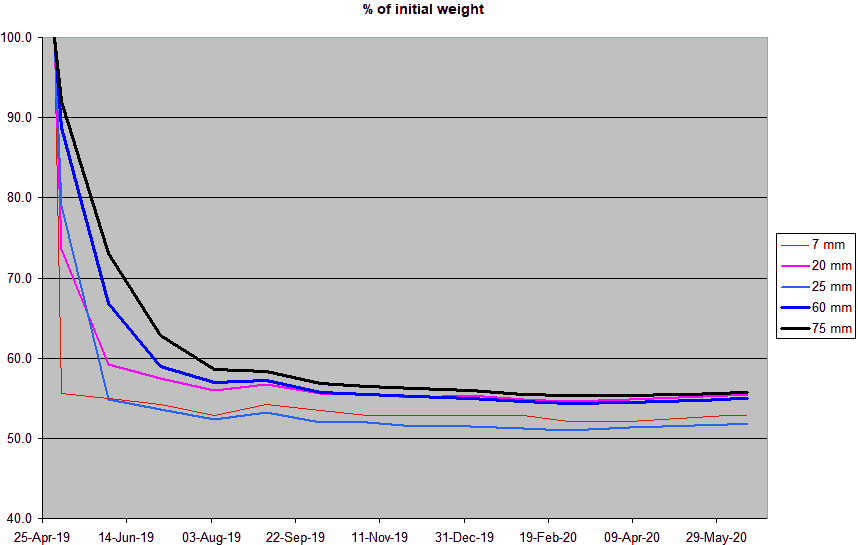 So nbsp;the weights over time as a fraction of initial weight.
So nbsp;the weights over time as a fraction of initial weight.
I plotted& The second set of readings was taken just four days after I initially cut up the wood and weighed it. The thinnest piece (thin red line), of just 7 mm thickness reached very near it's final weight after just four days. The next thinnest piece, purple line, was already half way to its final weight after four days. And after the first month, the three thinnest pieces ( 7mmm, 20 mm and 25 mm) were already near their final weight.
But the pieces of wood didn't all lose the same fraction of their weight. I assume that the log piece of log wasn't evenly saturated with water and probably already lost some of its water content even before I cut it to pieces.
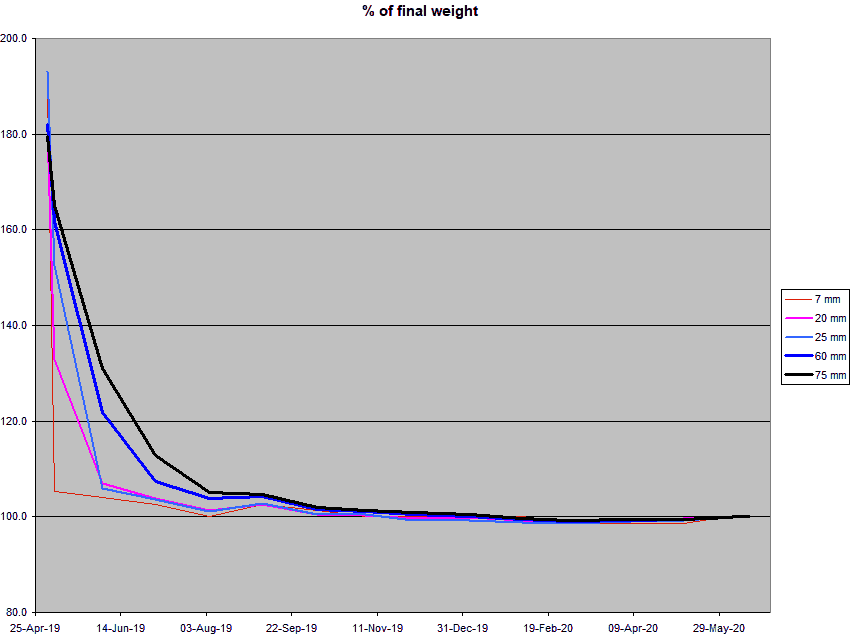 So I rescaled the lines to show a percentage of final weight of each piece.
So I rescaled the lines to show a percentage of final weight of each piece.
You can see that the pieces of wood all converged about five months in. I would expect that the thinnest pieces would have reached equilibrium long before the thicker pieces, so my conclusion is that the pieces were all very close to humidity equilibrium with their environment at about five months in.
Starting around April, the pieces started to gain some weight again, though the
change is hard to see on this scale of graph.
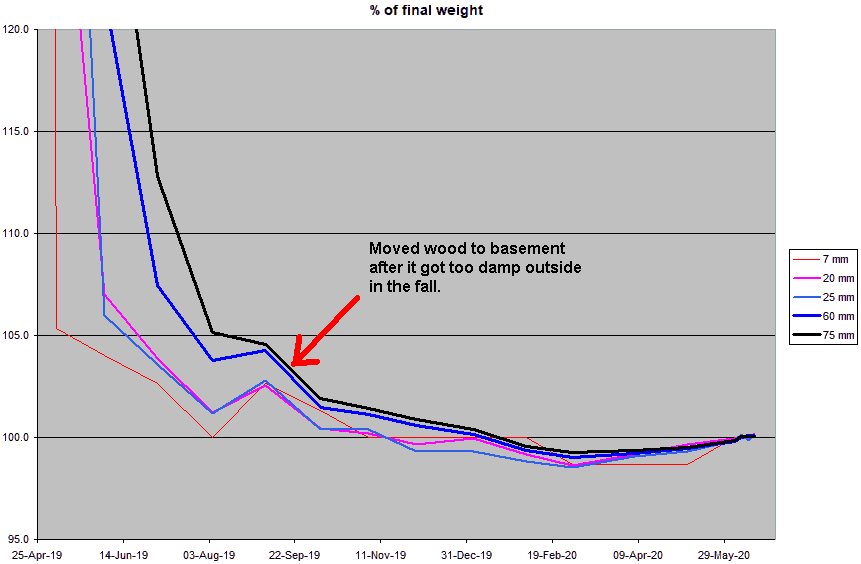 I rescaled the vertical axis to show small variations around the final weights
more closely. After five months, the weather outside started to get wet in the
fall, with all but the thickest pieces gaining weight on account of that.
So moved the wood into the basement, where it was dry and about 13-16 degrees Celsius
throughout the winter. You can also see how the thinner pieces have
more variations than the thicker pieces, which lost and gained moisture more slowly.
I rescaled the vertical axis to show small variations around the final weights
more closely. After five months, the weather outside started to get wet in the
fall, with all but the thickest pieces gaining weight on account of that.
So moved the wood into the basement, where it was dry and about 13-16 degrees Celsius
throughout the winter. You can also see how the thinner pieces have
more variations than the thicker pieces, which lost and gained moisture more slowly.
Because moisture can travel more easily along the grain than across it, it's
possible that for the thicker pieces, much, or most of the moisture came
out of the end grain, so that these drying times are shorter than they would be for
longer pieces. That said, the 75 mm thick piece dried slower than the 60 mm
thick piece. If drying was mostly through the ends, that would not have been
the case.
Conventional wisdom is that you should give wood one year to dry for each inch of thickness, but this experiment shows that given consistently dry conditions, wood can dry much faster even without a kiln. But conventional wisdom also assumes the wood is kept in a big stack outside, and the weather may or may not always be good drying conditions, and it probably won't dry much over the winter months.